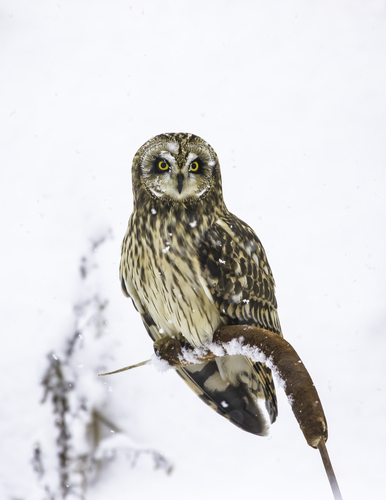
Short-eared Owl
The Short-eared Owl (*Asio flammeus*) is a medium-sized owl species known for its distinctive ear tufts, which are often not visible, and its crepuscular hunting habits. Unlike many owl species that are strictly nocturnal, Short-eared Owls are frequently observed hunting during daylight hours, especially at dawn and dusk. This behavior, along with their preference for open habitats like grasslands and marshes, makes them more visible than many other owls. They play a crucial role in controlling rodent populations and are considered an indicator species for the health of open ecosystems. Culturally, they are sometimes associated with folklore and omens, but they are generally viewed favorably due to their pest control benefits.
34-43 cm
Length
85-110 cm
Wingspan
Least Concern
Conservation Status
Distribution
Short-eared Owls have one of the most extensive global distributions of any owl species, found on every continent except Antarctica and Australia. They breed across North America, Europe, Asia, and parts of South America. Many populations are migratory, moving south in winter from northern breeding grounds. They exhibit a wide altitudinal range, from sea level to high-elevation grasslands.
Lifespan
The average lifespan in the wild is relatively short, typically around 4 years, although some individuals have been recorded living up to 12 years or more.
Short-eared Owl's Habitat
Habitat Types
Grasslands, Marshes, Tundra, Agricultural fields, Open woodlands, Coastal dunes
Climate Zones
Temperate, Boreal, Tropical, Subarctic
Adaptations
Their preference for open habitats is linked to their hunting style, which relies on low, coursing flights over open ground to detect prey. Their broad wings and light body weight facilitate this energy-efficient hunting method.
Variations
Several subspecies are recognized, differing slightly in size and plumage coloration. For example, *A. f. flammeus* is the widespread nominate subspecies, while *A. f. sandwichensis* is endemic to the Hawaiian Islands (and is known as the Pueo).
Appearance
Breeding Plumage
Plumage is generally similar year-round, but may be slightly brighter or more contrasting during the breeding season.
Seasonal Feather Changes
Minor, with fresh plumage after molting appearing slightly darker and more richly colored.
Sex Based Plumage Differences
Females tend to have slightly darker and more heavily streaked plumage than males, but the differences are subtle.
Notable Features
Small, often inconspicuous ear tufts (not always visible)., Large, yellow eyes with black eye-liner-like markings., Distinctive facial disc that aids in sound localization., Mottled brown, buff, and white plumage providing excellent camouflage.
Diet and Feeding
Primary Foods
Voles, Mice, Small rodents, Shrews, Occasionally small birds and insects
Foraging Behavior
Primarily hunts by coursing low over open ground, using its exceptional hearing and vision to locate prey. Often hunts during the day, especially at dawn and dusk, but can also be active at night.
Specializations
The facial disc acts like a parabolic reflector, channeling sound waves to the ears, allowing for precise prey location even under dense vegetation or snow.
Seasonal Diet Variations
Diet varies depending on prey availability. In some regions, they may switch to preying more on birds or insects during periods of low rodent populations.
Behavior
Social Structure
Generally solitary or in pairs during the breeding season. May form loose flocks during migration or in winter, especially in areas with abundant food.
Communication
Barking calls (often described as 'kee-ow'), Screams, Hoots, Wing-clapping during courtship displays
Migration
Many populations are migratory, undertaking long-distance movements between breeding and wintering grounds. Migration patterns are often influenced by prey availability.
Territorial or Group Behaviors
Territorial during the breeding season, defending nesting areas from other Short-eared Owls and potential predators. May roost communally in winter.
Conservation
Threats
Habitat loss and degradation (due to agriculture, urbanization, and afforestation), Pesticide use (reducing prey populations and causing secondary poisoning), Collisions with vehicles and wind turbines, Climate change (altering prey distribution and habitat suitability)
Protection Programs
Habitat restoration and management initiatives, Monitoring programs to track population trends, Research on the impacts of pesticides and other threats
Local National Laws
Protected under various national and international laws, including the Migratory Bird Treaty Act in the United States and the Birds Directive in the European Union.
Population Trend
Overall, the global population trend is considered stable, but some regional populations are declining.
Population Estimates
The global population is estimated to be between 2 and 6 million individuals, but estimates are difficult due to the species' wide range and nomadic behavior.
Interesting Facts
They are one of the few owl species that regularly nests on the ground.
This makes their nests and young vulnerable to predators and habitat disturbance.
They can sometimes be seen hunting alongside other raptors, such as Northern Harriers.
This shared hunting behavior may be due to overlapping habitat preferences and prey types.
Their flight is often described as 'moth-like' due to their buoyant, irregular wingbeats.
This flight style is well-suited for hunting in open habitats.
They are highly nomadic, with their movements often driven by fluctuations in rodent populations.
This makes them an indicator species for the health of grassland and other open ecosystems.
Faqs about Short-eared Owl
What do Short-eared Owls eat?
Primarily voles and other small rodents, but they will also eat other small mammals, birds, and insects depending on availability.
Where can I see a Short-eared Owl?
Look for them in open habitats like grasslands, marshes, and agricultural fields, especially at dawn and dusk.
Are Short-eared Owls endangered?
Globally, they are classified as Least Concern by the IUCN, but some regional populations are facing threats and may be declining.
Do Short-eared Owls hoot?
They do make vocalizations, including barks, screams, and hoots, but their calls are generally less frequent and less 'hoot-like' than some other owl species.
How can I tell a Short-eared Owl from a Long-eared Owl?
Short-eared Owls have much smaller and less prominent ear tufts (often not visible), and they are more likely to be seen hunting during the day in open habitats. Long-eared Owls are more strictly nocturnal and prefer forested areas.
Copyright @ Nature Style Limited. All Rights Reserved.
 English
English